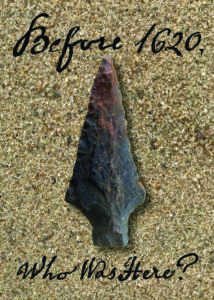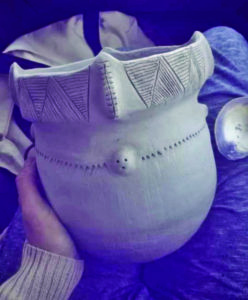WELLFLEET — On the official seal of the town of Wellfleet, a party of pilgrims rows ashore in a dinghy as a crowd of indigenous people wait on the beach. The scene is labeled “1620,” and is encircled by the words “Town of Wellfleet Incorporated 1763.”

Historically, this picture is completely false, says Sheryl Jaffe, coordinator of the Wellfleet Historical Society and Museum. “The implication is that [the pilgrims and Native Americans] encountered each other,” she says. “But, in reality, they never interacted like that. There was no welcoming party in Wellfleet. The pilgrims went by Wellfleet but never even landed here.”
A new exhibit titled “Before 1620: Who Was Here?,” with a panel titled “Muddled History,” will try to set the historical record straight when the museum reopens to the public on Wednesday, July 22.
The exhibit focuses on the Wampanoag presence in Wellfleet and features a large plexiglass case displaying 23 Indian artifacts found in Wellfleet and ranging in age from 3,000 to 12,000 years. They include pottery shards and “bifaces”: stone tools that are commonly misidentified as “arrowheads,” despite their predating the invention of the bow and arrow.
“We know from the Indian Neck ossuary and artifacts that people lived here for 10,000 years,” says Jaffe. “It’s important for us to learn about that.” The 23 artifacts in the case are just a small fraction of the museum’s collection, which includes about 300 items, all from Wellfleet. “What this tells us,” says Jaffe, “is that this place was very, very populated.”
The potential for a Wampanoag exhibit has long existed at the museum. “I noticed this glass case jumbled with artifacts,” Jaffe says of her first look around two years ago. “I didn’t know anything about them, but I could tell they weren’t well displayed. Archaeologists told me they were 2,000, 3,000, even 8,000 years old, and people started to get interested.”
A grant from Mass Humanities enabled the museum to hire a Wampanoag historian. “Learning about Wampanoag culture has been a great process,” Jaffe says.

The new exhibit goes beyond Wampanoag culture. It also examines the arrival of the pilgrims through a new lens, as 2020 marks the 400th anniversary of their landing and settlement. The broader goal, according to Jaffe, is to “bring a more enlightened perspective on the history of indigenous people of what is now Wellfleet.”
“Before 1620: Who Was Here?” explores the lost history of Native Americans.
“One of the elements in the exhibit is a deed from 1715 that dedicates Indian Neck exclusively for the use of Wampanoag people and their descendants,” Jaffe says. The details of how Indian Neck came back under English control are unclear, but less than 20 years later the land was sold. The deed is a reminder that there were Indian reservations in Wellfleet, which may come as a surprise to local residents. “We’ve been robbed of so much history,” says Jaffe.
Other features of the exhibit focus on modern Wampanoag people. One of the panels, titled “We’re Still Here,” features a Wampanoag genealogy with antique photos tracing families back five or six generations.
The display also features a pot, made by a local Wampanoag artist using traditional techniques, and wampum — beads that served a wide variety of purposes, including expressions of emotion and condolence, and a sense of harmony with all life.
“Most people don’t know much about the Wampanoag presence on Cape Cod,” says Jaffe. “We hope to teach people that the culture is still here — and thriving.”
The new educational panels and the museum’s consultancy with Wampanoag experts are a stark contrast to the days between 1953 and 1976, when the museum displayed the bones of a Native American woman as part of an exhibit. The remains were eventually reburied in a 1976 ceremony, but the inscription on her gravestone included the phrase “whose family and tribes gave of themselves and their land that this great nation might be born and grow.”

A panel in the new exhibit tells this story, explaining, “Wampanoag families and tribes did not ‘give of themselves and their land.’ Rather, people were constantly pressured and encroached upon by the English.”
Jaffe hopes to right past wrongs, adding, “We’re also raising money to change the stone.”
She believes that the importance of the exhibit goes beyond educating local people about the land they live on. Even in scholarly circles, she says, the other side of the pilgrim story is seldom taught.
“Those of us who consider ourselves educated have never learned indigenous history,” says Jaffe. “Native stories should be an important part of what ‘educated’ people learn.”
“Before 1620: Who Was Here?” will be available for viewing from Wednesday through Saturday from 1 p.m. to 4 p.m.
Reporting for this article was supported by a grant from the Wellfleet Cultural Council, a local agency supported by the Mass. Cultural Council.



